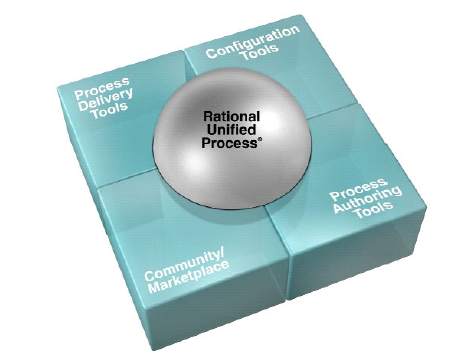The Rational® Unified Process® (RUP®) is a commercial software development
process framework. The RUP is composed of:
- Best practices. The RUP includes a library of best practices for software
engineering, covering everything from project management to detailed test
guidance.
- Process delivery tools. The RUP is delivered using Web technology, allowing
it be integrated with other software development tools and making it easily
accessible to developers.
- Configuration tools. The RUP is made up of components and plug-ins that
can be selected and configured to meet the needs of different kinds of
projects.
- Process authoring tools. An organization can extend or modify the RUP by
creating its own plug-ins using the Rational Process Workbench® product.
- Community/marketplace. The Rational Developer Network® (RDN™)
provides a place for process engineers in the software development
community to share their process extensions.
Figure 1 Rational Unified Process
The RUP is a process framework consisting of process delivery tools,
configuration tools, process authoring tools, and a community/marketplace of
process plug-ins.
Software development best practices
The RUP is a software development process framework that provides a
disciplined approach to software development. Its goal is to ensure the
production of high-quality software that meets the needs of its end users within a
predictable schedule and budget.
Central to meeting this goal is promoting commercially proven “best practices.”
These best practices include:
- Develop iteratively.
- Manage requirements.
- Use component-based architectures.
- Visually model software.
- Continuously verify software quality.
- Control changes to software.
Develop iteratively
System functionality should be delivered in a successive series of releases,
addressing critical risks and getting feedback in the early releases.
Manage requirements
Requirements management is a systematic approach to eliciting, organizing,
communicating, and managing the changing requirements of a
software-intensive system or application.
Effective requirements management enables better control over customer
satisfaction, budget, and schedule.
Use component-based architecture
The Rational Unified Process provides a methodical, systematic way to design,
develop, and validate an architecture. Architectures based on components are
more flexible, reusable, and understandable than architectures based on other
approaches.
Visually model software
Models are simplifications of reality; they help us to understand and shape both a
problem and its solution and to comprehend large, complex systems that we
could not otherwise understand as a whole. RUP uses the Unified Modeling
Language (UML), a standard graphical language for visualizing, specifying,
constructing, and documenting software-intensive systems.
Continuously verify quality
Quality is the responsibility of every member of the development organization; it
isn’t added by specialized staff at the end of the project. Quality is managed
throughout the life cycle by implementing and assessing both process quality and
product quality.























 1346
1346

 被折叠的 条评论
为什么被折叠?
被折叠的 条评论
为什么被折叠?








